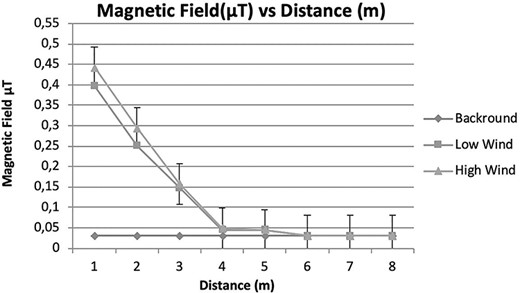Does EM radiation from wind turbines pose a threat to human health?
What the science says...
Multiple studies have found that the electromagnetic fields (EMFs) generated by wind turbines are lower than those generated by most common household appliances and that they easily meet rigorous international safety standards.
Electromagnetic radiation from wind turbines poses a threat to human health
"Recently, concerns about exposure to EMF from wind turbines, and associated electrical transmissions, have been raised at public meetings and legal proceedings.” (Ohio Department of Health)
Multiple studies have found that the electromagnetic fields (EMFs) generated by wind turbines are lower than those generated by most common household appliances and that they easily meet rigorous international safety standards (McCallum et al. 2014, Alexias et al. 2020, Karanakis et al. 2021). For context, the average home that is not located near power lines has a background level EMF of roughly 0.2 µT1. However, this value varies greatly depending on proximity to certain household appliances1. For example, from a distance of 4 feet, an electric can opener’s EMF is 0.2 µT, but this value increases to 60 µT from a distance of 6 inches2. A 2020 academic study found that the EMF generated by turbines are approximately 0.44 µT at a distance of 1 meter but less than 0.1 µT at a distance of 4 meters, as shown below (Alexias et al. 2020).

Figure 10: The EMF level, measured in microtesla (µT), is shown to drop dramatically with increase in distance from source. Source: Alexias et al. (2020)
These EMF levels are not dependent on wind speeds.
Footnotes:
[1] Radiation: Electromagnetic fields, World Health Organization (August 4, 2016)
[2] Electromagnetic Fields (EMF), Wis. Dep’t. of Health Serv. (Sept. 14, 2022)
This rebuttal is based on the report "Rebutting 33 False Claims About Solar, Wind, and Electric Vehicles" written by Matthew Eisenson, Jacob Elkin, Andy Fitch, Matthew Ard, Kaya Sittinger & Samuel Lavine and published by the Sabin Center for Climate Change Law at Columbia Law School in 2024. Skeptical Science sincerely appreciates Sabin Center's generosity in collaborating with us to make this information available as widely as possible.
Last updated on 26 October 2024 by Sabin Center Team. View Archives































 Arguments
Arguments





























Climate Myth...